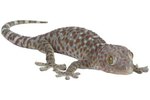
When your gecko is scurrying about in his tank, it's impossible to tell whether he's a he or actually a her. But pick your pal up and inspect his underside, and you'll see some very noticeable characteristics that a girl gecko won't have and a boy will. If you plan on buying more geckos, knowing your gecko's gender is paramount to a peaceful and baby-less environment. Females can be kept together, but males can't.
Handling
Determining whether you have a boy gecko or a girl gecko calls for picking up your pal. Warning: Your gecko will probably be spooked if you suddenly stick your hand in his enclosure and snatch him up. The Long Island Herpetological Society suggests placing your hand palm up in his enclosure and herding him into it. Cradle him very gently, applying only enough pressure to keep him from falling out or wiggling free. Immediately sit on the floor or somewhere that your gecko won't be injured if he twists out of your hand. Never grab his tail -- that would make him cast it off, exposing him to infections until it regrew.
Hemipenal Bulges
The sexual organs of a male gecko are known as hemipenes. Upon reaching sexual maturity, evidence of hemipenes develops as two bulges immediately beneath his vent, the little horizontal slit at the base of his tail. These bulges conceal the hemipenes until the male mates with a female. The bulges aren't awfully big, but they're certainly noticeable. This is a guaranteed way to determine whether you have a male gecko or a female gecko -- females do not develop bulges.
Preanal Pores
Female and male geckos both have preanal pores, but a female's are essentially invisible, while the male's are clearly visible. These pores allow a gecko to excrete a waxy substance that contains pheromones. The gecko rubs this on surfaces where he walks, to tell other geckos that this is his piece of land. The pheromones also help a gecko court mates. Look a smidgen above your gecko's vent. If your pal is a male, he should have small pores that resemble tiny dots. The pores should be arranged in something of an upside down V-formation.
Other Features
Generally, male geckos have larger frames than females, have broader heads and look all-around thicker. Some male gecko species have femoral pores, which look similar to preanal pores except they're on the back thighs and arranged in a line. At the base of your gecko's tail, you'll probably see what look like tiny thorns. Both sexes have these cloacal spurs, but a male's are usually larger. These characteristics alone cannot guarantee whether you have a boy or girl gecko. Sometimes girls match a boy's size, have dimples that resemble femoral pores and show cloacal spurs that look identical to a male's.
Age
As with most reptiles, the differences between male and female geckos typically aren't apparent until they mature a little bit -- not necessarily sexually mature. Their characteristics and sex organs, specifically the male's, need time to become noticeable and defined. You typically can see the contrasts between males and females at around 4 or 5 months of age. This is just a general rule. Every gecko develops differently, and to be absolute certain you have a male or female, you should research at what age you can sex your specific species. For instance, you can sex leopard geckos when they're 3 to 4 months old, but crested geckos don't develop their sexual characteristics until they're around 6 months.
References
Photo Credits
-
Jupiterimages/Photos.com/Getty Images
Writer Bio
Located in Pittsburgh, Chris Miksen has been writing instructional articles on a wide range of topics for online publications since 2007. He currently owns and operates a vending business. Miksen has written a variety of technical and business articles throughout his writing career. He studied journalism at the Community College of Allegheny County.




